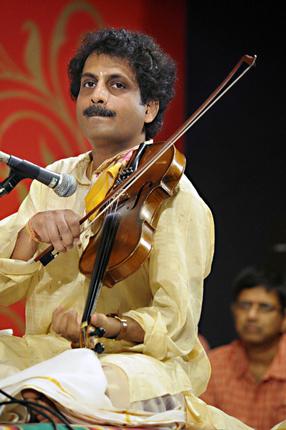Every two minutes the audience applauded ecstatically. Requests were streaming in, there was a small mound of chits before the artistes. Behind me, from the fairly large audience, I heard whispers: ‘What a genius!’, ‘Wow, what speed.’ That done, they went back to chatting with their companions to the concert, took selfies, sauntered in and out, a quick coffee at the canteen etc. It was afterall possible to catch up with what was happening on stage at any point.
Even if it is not your favourite musician, it is good to be at the Ramanavami pandal once in a while to catch up with what’s happening in the music world.
The concert that was taking place at Fort High School was violin-mandolin duet by Mysore Manjunath and Mandolin U. Rajesh, accompanied by Thiruvarur Bhaktavatsalam on the mridanga and Giridhar Udupa on the ghatam. The very able Mysore Manjunath, groomed by his renowned father Vidwan Mahadevappa in the traditional Carnatic style, is much sought after in the international concert circuit considering his felicity with the violin. U. Rajesh is also widely acclaimed for his collaborations within the country and with western music groups. So, by the sheer choice of artistes, one fairly knows what to expect.
Carnatic music is traditional, conservative, and rigid – so goes the popular notion. If varna is the opening, if it is followed by a quick madhyamakala kriti, if it is then followed by a longer vilambakala kriti with alapane, neraval and swarakalpana and so on – all is well. Tradition is in safe hands. The audience is happy that all the pre-requisites are met.
Let’s take for instance, the piece de resistance of the concert. The ragam-tanam-pallavi in Simhendra Madhyama. Jugalbandis are undeniably about each musician bringing his own idea to the table, it is also however about an underlying harmony, and a shared vision. Manjunath played his part of thealapane – there were long, western concerto passages, there were Hindustani phrases, and suddenly, like a reminder, came Carnatic in a flash. Rajesh played staccato notes, and his parts were heavily inspired by film music. In between, for the tanam, they soared and plummeted the octaves in breakneck speed. Natakuranji, Bilahari, Desh and other ragas came, in complete absence of their selves. It was stream of consciousness, defiant to inherent structure, replete with broad brush strokes and high decibel. Thiruvarur Bhaktavatsalam added his bit – what’s moderation he seemed to ask as he thundered through his tani avartanam. The sedate, composed Giridhar Udupa held on bravely. There were bright moments, brilliant strokes – but parts hardly make for a whole.
But, there were thunderous applauses.
I am no conformist – I can listen and appreciate any kind of music rendered in its own way. I am sure there were many that evening who felt the way I did. This eclectic blast that tossed one between time-tested notions of tradition and avant gardism, seemed to have none of either.
Then maybe tradition is simply about donning an exterior? And maybe we, as audiences, love to fuss about a traditional core but actually find facades irresistible.
source: http://www.thehindu.com / The Hindu / Home> Features> Friday Review / Deepa Ganesh / Bengaluru – April 28th, 2016
